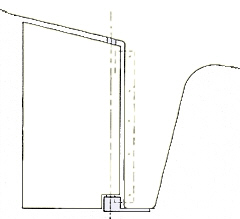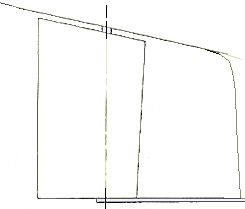| QUESTION: Why is the Rudder/Skeg Combination such an important design element? | ||
| ANSWER: It is important because it results in better steering control. Tests show that with a full length skeg directly in front of the rudder, the stall angle of the rudder is substantially increased. During times when it is needed most, as in heavy seas or tight docking maneuvers, a more powerful turning moment is generated with a rudder/skeg combination. | ||
|
Rudder/Skeg Combination |
||
| Caliber Rudder/Skeg System | Versus | Rudder with No Skeg System |
 |
 |
|
| Smooth laminar flow creates strong turning moments | Stalled turbulent flow results in low turning moments | |
 |
 |
|
|
Equal angle of attack |
Equal angle of attack |
|
| From "Yacht Designed Explained" by Steve Killing, Douglas Hunter | ||
| “The skeg, which sits solidly in front of the rudder, performs two functions--the first hydrodynamic, the second structural. Because the skeg is mounted on centerline and is at a constant angle to the incoming flow, it never sees a very high angle of attack, and the likelihood of stalling is greatly reduced. When the rudder is turned, it forms with the skeg a shape approximating that of an efficient, cambered foil, which can produce high lift values." | ||
| From “Ted Brewer Explains Sailboat Design” by Ted Brewer | ||
| “The benefits of a skeg ahead of a rudder are numerous. The skeg raises the stall angle at which the rudder will lose its lift; it provides a greater control surface area thereby adding to directional stability; it offers better control than a spade rudder when there is a high flow angle of attack, i.e., in case of a serious broach." | ||